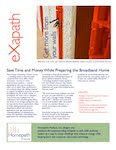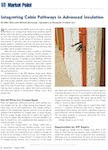 |
| Suspension Buster |
Hum the melody to the Stealers Wheel classic (often mistaken for The Beatles) “Stuck in the Middle with You” and sing the following modified lyrics and you’ll see what I mean:
Well, I don’t know why I came here, tonight
I’ve got the feeling that something ain’t right
I’m so scared in case I steer the wrong way
And I’m wondering how much I will pay
Cars to the left of me
Snowbanks to the right
Here I am
Stuck in a pothole with you
Add procrastination to decades of physical weathering and here we are. There’s nowhere to hide. Pay now or pay more later. Later is now.
Infrastructure
We hear this term sparking political debate and the news seems to feed from it. For many, author included, the mere mention of infrastructure connotes higher taxes and out-of-pocket dollars when we can least afford them. The phrase often references a public civil project that sees heavy use by many, and is in constant need of costly repairs. Our tax dollars are collected and used to build and then maintain. - or repair - public infrastructure. The story is the same whether we speak of roads and highways, civic centers, telecommunications networks, airports, or high speed rail. Some public, some private - all infrastructure. We hotly debate their initial construction, eventually acquiesce and then build commerce around them for generations. We freely enjoy ourselves and blissfully ignore their inevitable decay. Eventually we rebuild and the cycle repeats.
I don’t know about you but I appreciate our system of interstates, barely a day goes by without my use of them. I often wonder how arduous travel was and how slow commerce happened before we committed to building them. Telecommunications infrastructure enables similar economic expansion...what would we all do if the internet were to disappear today?
Much recent prosperity in the United Sates was enabled by infrastructure investments made generations ago. It’s interesting to note that China has entered infrastructure build-out mode and on a scale that’s difficult to comprehend without seeing it first-hand. China is making the infrastructure commitments that will enable economic growth for future generations.
We now need to rebuild.
Wondering
The potholed infrastructure dilemma got me wondering. I’m far from a highway designer but I know a fair amount about infrastructure. The infrastructure I deal with surrounds our living spaces and, as any homeowner will tell you, changing home infrastructure can be as unattractive and painful as writing big checks for increased taxes. The primary difference being that the value of home infrastructure goes directly to the home or building owner - or benefits the next individual who buys the home.
At Homepath Products, with the eXapath in-wall cable pathway system, we make infrastructure with a unique benefit. It may be more accurate to say that eXapath is the infrastructure for infrastructure...I’l explain below.
 |
| Designed for today's most advanced insulation products, eXapath provides a permanently accessible channel for entertainment cables. |
What if you had a way to install the low voltage wires you need today and a simple way to remove and replace them as they become obsolete. No fishing, no insulation displacement. Infrastructure for infrastructure.
 |
| eXapath in-wall cable pathways turn your framing into information superhighways, ready for low voltage cables when you need them. |






.jpg)


Nice analogy, Mike. With a little more foresight, so much construction could adapt to change much more easily. Go Homepath!
ReplyDeleteNot to mention, Mike, the fact that the NEC (National Electric Code) suggests removing old communications cabling from bulidings or tagging it for future use. How often is one going to use that old telephone wire any more after tagging it? I think not... The main reason for removing the old cabling is to attempt to reduce the amount of "fuel" in the walls when there is a fire. And, who pays for it? If you are a landlord in an MDU, and a tenant moves out after installing some poor quality TV or computer cables, are you going to pay to have the walls torn open and the old cables removed? It seems to me that the eXapath cable pathway system is the ideal choice for that flexibility when it's needed.
ReplyDeleteHave you been to NYC? We have horrible potholes here.
ReplyDeleteThanks Leah...and I completely agree. Adaptability is a key component in our sustainable future and helping residential and commercial structures keep pace with change is a big part of what we promise.
ReplyDeleteThanks for the note.
Mike
Randy,
ReplyDeleteAbsolutely...out with the old, in with the new...and in no time flat. Actually, obsolete and aging cables that remain within the walls is a serious fire load and hazard. Being able to remove them before upgrading helps minimize risk.
Thanks,
Mike
MC,
ReplyDeleteHave I been to NYC to see your potholes? You bet, in fact, the last time I passed through I'm sure I noticed a contented family living in one of them. You guys know how to grow 'em!
Thanks,
Mike
What a very interesting article! Getting stuck in a pothole is not really awesome!
ReplyDelete